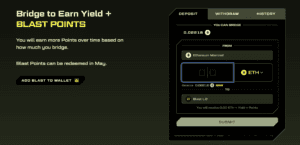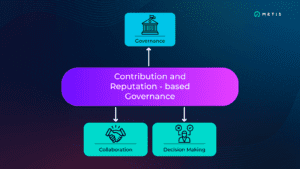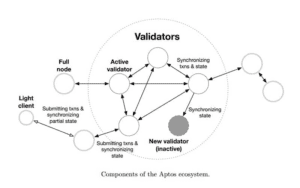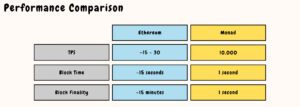General




What will the next Solana be?
Earlier in the year we told you about Solana’s ambition to become the strongest competitor to Ethereum, as we explained in this article:
Solana: get the latest on Ethereum’s fast-growing competitor. – DEXTools
But there are other similar projects on the horizon, and we’ll tell you about some of them below.
![]() Solana is an open-source blockchain project at the forefront of next-generation decentralized applications (DApps) development. As a rapidly growing competitor to Ethereum, Solana strives to provide a platform that is highly scalable, secure, and maximally decentralized. Solana aims to support potentially thousands of nodes without relying on costly, energy-intensive hardware.
Solana is an open-source blockchain project at the forefront of next-generation decentralized applications (DApps) development. As a rapidly growing competitor to Ethereum, Solana strives to provide a platform that is highly scalable, secure, and maximally decentralized. Solana aims to support potentially thousands of nodes without relying on costly, energy-intensive hardware.
Here you can access Solana in DEXTools:
https://www.dextools.io/app/en/solana/pairs
What characteristics should the next Solana include?
The next Solana-like blockchain should combine speed, affordability, decentralization, and developer-friendly features to empower crypto community.
- High Throughput: Like Solana, it must handle a large number of transactions per second (TPS) efficiently. Scalability is crucial for widespread adoption.
- Low Fees: A competitive advantage would be low transaction fees, making it accessible to users of all economic backgrounds.
- Decentralization: Striking a balance between scalability and decentralization is essential. A robust consensus mechanism should ensure security while allowing for rapid TPS.
- Developer-Friendly: A rich ecosystem with easy-to-use tools, documentation, and developer support will attract talent and foster innovation.
- Interoperability: Seamless integration with other blockchains and protocols enables cross-chain communication and enhances utility.
Below, we show you a list of blockchains with similar characteristics to Solana which could emulate its success closely.
The new Solana: 5 candidates that could make a splash
Maybe you have your own favorite, but we have chosen for you 5 nominees to give Ethereum a fight in the near future: Blast, Metis, Aptos, Nibiru and Monad.
Let’s break them down one by one!

Blast.io website
1-Blast: Ethereum Layer 2 network with unique features
- Blast, an independent Ethereum Layer 2 (L2) network, tackles Ethereum’s scalability issues by operating over the Ethereum mainnet, aiming to alleviate speed, cost, and scalability bottlenecks.
- Its distinctive design enables depositors bridging their ether (ETH) to Blast to start earning yields on transferred assets, including Blast points representing participation in ETH staking.
- Yield generated from staking is redistributed to L2 users and decentralized applications (dApps).
- Blast provides returns in both ETH and stablecoins, featuring automatic ETH rebasing for effortless yield acquisition and a T-Bill yield for stablecoins via its USDB (Blast’s own coin), boosting asset value and market efficiency.
- This stablecoin mechanism adapts traditional finance strategies to DeFi.
- Accessible via invite-only access codes, it extends the Blur ecosystem, offering yield opportunities on idle assets and refining infrastructure for advanced NFT products.
- With a focus on native yield, community governance, and scalability, Blast aims to drive innovation in the crypto sphere covering multiple dimensions.
Here we explain how to bridge your funds from Ethereum to Blast:
BLAST L2 First Steps Guide for Beginners – DEXTools
And here you can access Blast in DEXTools:
https://www.dextools.io/app/en/blast/pairs

Contribution and Reputation-based Governance in Metis. (Source: metis.io)
2-Metis: a blockchain intended for the creation of dApps and the Web3
- Metis, a permissionless Layer 2 network, empowers the next generation of Ethereum dApps, addressing the blockchain trilemma of decentralization, security, and scalability. Serving as an Ethereum Layer 2 scaling solution, Metis enhances application performance and efficiency.
- Key features include Superfluid Self-Sustainability, Web3 Acceleration, and Frictionless Integration.
- Decentralized Ecosystem Governance (DEG) fosters community-driven decision-making. Metis offers permissionless development, streamlined project integration, scalable infrastructure, cost-effective on-chain storage, and swift transactions with minimal gas fees.
- Community participation through DEG ensures inclusivity and decentralization, placing power in the hands of users.
- Metis aims to revolutionize Ethereum scalability, empower developers, and create a decentralized ecosystem where community voices shape its evolution.
Here you can access Metis in DEXTools:
https://www.dextools.io/app/en/metis/pairs

Aptos ecosystem. (Source: cryptopolitan.com)
3-Aptos: The World’s Most Production-Ready Blockchain
4-Nibiru: a secure smart contract platform powered by a dynamic community
- Nibiru Chain represents a decentralized blockchain owned by the community, built for a next generation Web3 experience.
- Nibiru Chain is a proof of stake blockchain (PoS) aiming to create a universal Web3 hub, combining the user-friendly experience of traditional alternatives.
- Built using the Cosmos SDK and Tendermint Core consensus, Nibiru can communicate with other blockchains via Inter-Blockchain Communication (IBC).
Key features of Nibiru include:
- Searchable Index: Nibiru provides a searchable index of blockchain data, enabling Web3 projects to track user behavior, monitor network activity, and make informed decisions.
- Oracle Module: With a robust Oracle Module, Nibiru addresses current platform limitations, offering a secure and efficient blockchain solution.
- Improved Incentive Model: Developers benefit from an incentive model tied to Total Value Locked (TVL) in smart contracts, promoting ecosystem growth and reducing manipulation risks.
- Nibi-Perps: Nibiru introduces Nibi-Perps, a perpetual futures Decentralized Exchange (DEX) supporting up to 10x leverage trading across digital assets within and beyond the Cosmos ecosystem.
- Nibi-Swap: Nibiru’s automated market maker (AMM) protocol, Nibi-Swap, facilitates spot trading for multichain assets, liquidity pools, and bonded liquidity gauges

Performance Ethereum vs Monad (Source: mirror.xyz)




